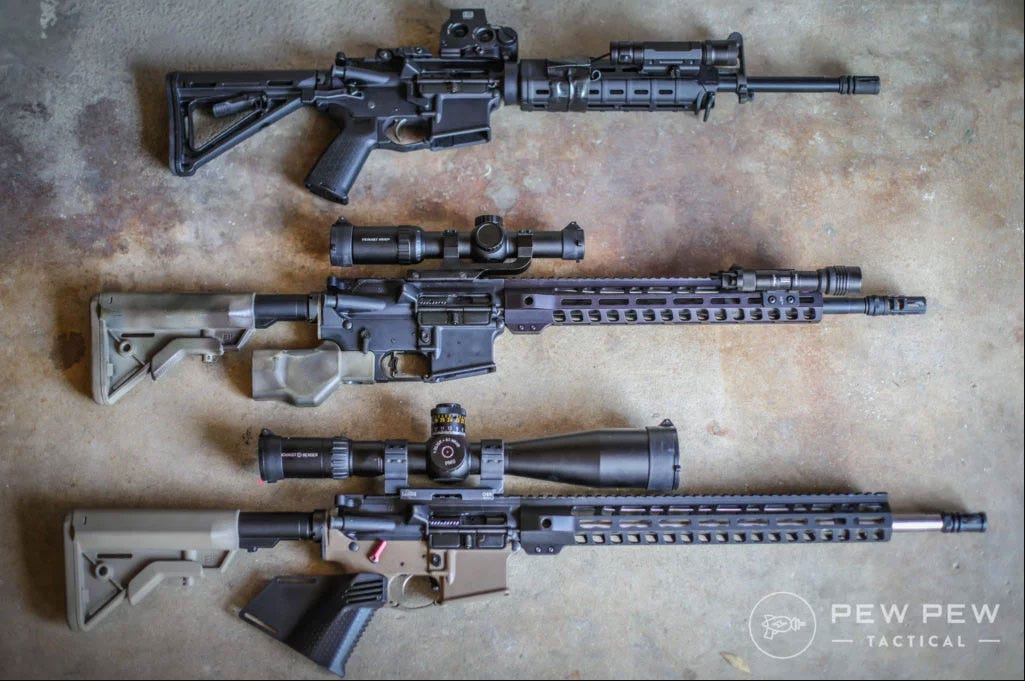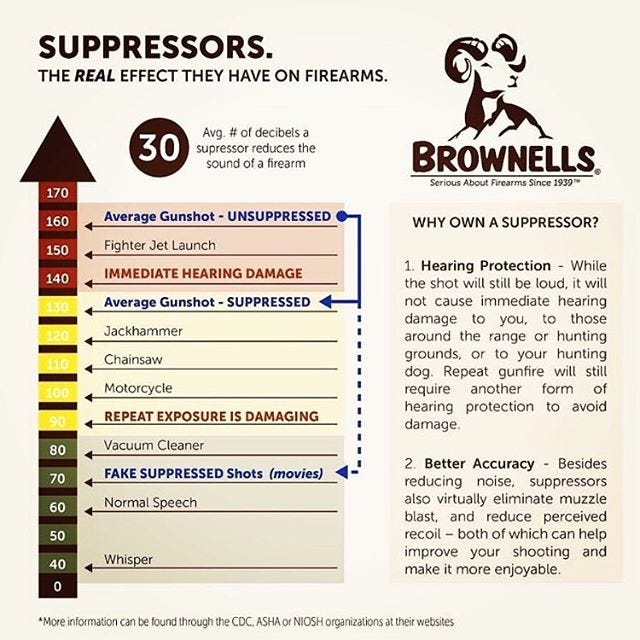OSD 143: Silencers are the perfect gun accessory. So why aren't they everywhere?
Hearing protection is haram.
The crew at Polenar Tactical ordered a silencer from AliExpress and tested it out:
It was about as flimsy as you’d expect, but hang on a second. “Ordered a silencer from AliExpress”? You can just … do that?
Well, sure, you can do whatever you want. But at the beginning of the video, Žiga mentions how they did it legally: “In Slovenia we recently got an update to our firearm laws, and one of the good sides of it was that suppressors are now completely legal and unregulated.”
Nice. For the initiated, that seems like the obvious choice. But why isn’t it obvious to everybody? Why isn’t today’s Overton window on suppressor laws where we think it should be, which is roughly coterminous with the Overton window on chewing gum regulation?
Well, one standard explanation for how gun laws come about goes something like this:
Someone commits a mass murder using a particular type of weapon.
Gun control groups and some politicians make a reasoned cost-benefit calculation about that type of weapon, and then decide it ought to be banned.
A debate ensues between those parties and gun rights advocates about how much harm the weapon in question causes or prevents, and what in fact, if anything, ought to happen to it.
This view doesn’t have much predictive power if you’re trying to model gun control groups’ behavior. It explains aspects of the 1989 assault weapon ban and of various state-level bans. But it only takes you so far, because it (incorrectly) implies that there cases where the model’s output isn’t “ban it”. As bans deviate from targeting functional differences, this model quickly loses its explanatory power.
For example, standard-capacity magazines do make a functional difference. Gun rights folks say that that’s no reason to ban them, that effective weaponry is the whole point of the right of self-defense, and so on. Gun control groups agree that mags make a functional difference, but believe that police are the only people trustworthy enough to have them. So it’s a debate, but it’s at least mostly internally consistent. It’s about whether a weapon’s effectiveness accrues more to defensive or offensive users, and about who should even get to make the call.
Moving to assault weapon bans, that coherence starts to falter. Here’s a photo from the good folks at Pew Pew Tactical. The rifles below are functionally identical, but note the difference in the grips. In California, the grips on the bottom two rifles are perfectly legal, but the grip on the top one will send you to prison for up to three years.
Why? The shape of the top one is defined as an “assault-style” shape of grip, and it’s a felony in California to have one of those. That shape of plastic is illegal.
But even on this, people at least bother to gesture at a cost-benefit calculation. Everytown has a fact sheet on their site about assault weapon bans. It’s very hand-wavey; and yes, it’s based on the sort of low-effort correlational claims that keep statistics teachers up at night; but hey, it’s an effort. They’re at least going through the motions of, “We did science and these specific grips are killing people.”
But this model of the debate finally fully collapses when you get to silencers. Silencers reveal a new model that has much more explanatory power: it’s not a debate about numbers, it’s a disagreement about what should be normalized and what should be stigmatized.
To understand this, first we have to understand silencers. And the basics are, well, pretty basic: suppressed gunfire is still incredibly loud. Here’s a chart from Brownells:
Suppressed gunfire is 10 decibels louder than a jackhammer. Decibels are a logarithmic scale, so +10 dB means 10 times the sound pressure. Because pressure dissipates in three dimensions, perceived loudness grows as the cubic root of the sound pressure. Therefore 10 times the sound pressure is a touch more than double the perceived volume.
In other words: suppressed gunfire is twice as loud as a jackhammer.
Unless they’ve been present when a bomb goes off, unsuppressed gunfire is the loudest sound a person will hear in their life. A silencer takes gunfire from that down to something twice as loud as a jackhammer. Still loud, and it’s still important to wear hearing protection, but the noise is just short of the level that will cause instant permanent hearing damage.
You can hear a jackhammer from blocks away. So the first-order good news is that you can hear suppressed gunfire from at least that far.
But wait, there’s more. Silencers are actively harmful for criminals. On one hand, they add zero criminal utility: the gun’s still audible from blocks away, and still pops up on ShotSpotter. And on the other hand it only gets worse: silencers are less concealable, one more point of failure, and less disorienting to victims. (By definition an attacker has more time to plan than defenders do, and so can bring hearing protection. Victims can’t.)
There’s strong real-world evidence that silencers aren’t useful for criminals: they’ve been trivial to illegally manufacture at home for ages (buy-an-oil-filter-at-Pepboys trivial), but they’re essentially never used in crime. Concealability is the overriding priority for criminal effectiveness, as BJ Campbell explained.
If criminals wanted silencers, they would already have them. There hasn’t been anything stopping them. The reason they don’t use them is because, well, they’re a net negative if you have criminal intent.
It turns out, then, that silencers are the perfect accessory. They increase safety for lawful shooters; make it easier to teach newbies; are only useful in self-defense, in hunting, and in recreation; and are actively counterproductive for criminal violence. According to the model we started this essay with, gun control groups should love silencers.
Narrator: “They did not love silencers.”
Our first model, where this is a debate about costs and benefits, cannot account for this. Silencers are manifestly a net positive.
Our second model explains this a lot better. In a debate about what to normalize and what to stigmatize, anything that helps normalize the thing you oppose is ipso facto bad. So to repeat the virtues of silencers from above: they make shooting safer and easier to learn, and only benefit lawful shooters.
But in this halal vs. haram model, that’s not a feature, that’s a bug. The problem with silencers is that they only benefit lawful shooters — they accrue 100% towards normalization and 0% towards stigma.
So in that sense, depending which meme someone’s trying to spread, that makes silencers pretty dangerous after all.
It also makes them an efficient sorting function. Anyone opposed to silencers is probably using a “kosher or unclean?” mental model when they think about guns. That’s no reason to judge them — that model is perfectly normal for people who, like most, are busy and only hear about this stuff in passing. It simply gives you a useful signal about where they’re starting from on this.
This week’s links
Apparently there’s a training round for the RPG-7
Fires a standard 7.62x39mm out of an inert rocket that has a barrel in it.
Radio direction finding
a.k.a. how “they” can find you
Interesting science on this stuff.
“There’s no Second Amendment on the south side of Chicago”
Most critically, however, my office sees the profound and oppressive impact of disproportionate gun arrests on the people we represent. We see how, far from ending gun violence, this form of “gun control” completely undermines public health and safety. The people we serve face a dual threat: harm from a community awash in violence — and harm from a system awash in incarceration.
OSD office hours
If you’re a new gun owner, thinking about becoming one, or know someone who is, come to OSD office hours. It’s a free 30-minute video call with an OSD team member to ask any and all your questions.
Merch
Top-quality clothing and patches, with if-you-know-you-know ✨ vibes ✨.
Support
Like what we’re doing? You can support us at the link below.






I found it entertaining that one of the weekly links out from the article on silencers and how great they are contains a couple of sentances about how silencers should not be legal.
Sharone Mitchell Jr. writes:
There are ways to achieve gun safety that do not create more victims in the process. We need to reduce the flow and use of guns into communities, repeal gun industry immunity, educate all gun owners and possessors on safe use and storage, implement targeted buybacks, and prohibit manufacture of assault weapons, silencers, and high-capacity magazines.
Love what you guys are doing, keep it up!